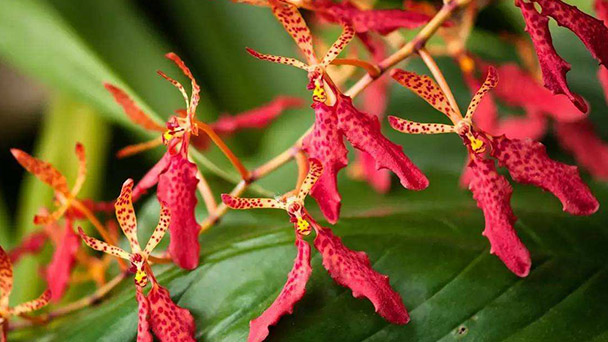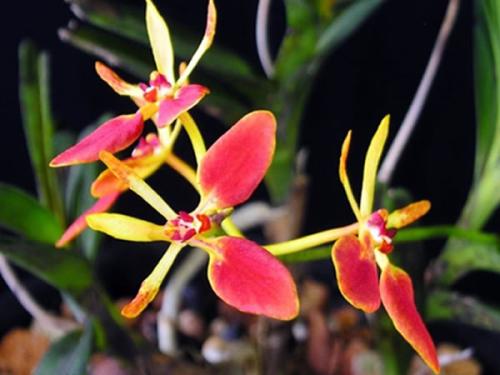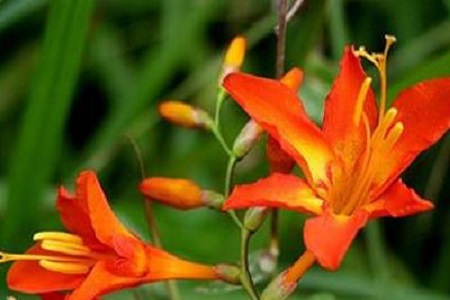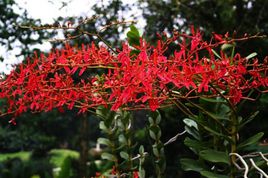Renanthera coccinea: care & growing tips
Written by Maggie
Mar 09 2021

First of all, let me introduce some growth habits of Renanthera coccinea. This is very important for growing and caring. Renanthera coccinea is a plant that likes sunlight, but it can also withstand severe cold. It does not require too much soil. The well-drained and loose and fertile sandy loam is best for its growth. It must have sufficient water during its growth period. Meet growth needs. Renanthera coccinea generally grows on the edge of a ditch or on a rock. The flowering time is in spring and summer.

1. Planting Renanthera coccinea:
Renanthera coccinea is a creeping plant, and its spurring power is relatively strong. Before planting, the soil must be fully plowed and sufficient basal fertilizer should be applied. When planting, pay attention to the depth of 5 cm, so that the bulb can be bloom in June of the year they are planted, but the smaller ones will bloom in the next year.
2. Temperature care for grpwing Renanthera coccinea:
The most suitable temperature for the growth of Renanthera coccinea is between 18 degrees and 35 degrees. In winter, it needs to be kept indoors for breeding. Generally, if the temperature is right, Renanthera coccinea has no dormancy period.
3. Light care for growing Renanthera coccinea:
Renanthera coccinea prefers sunlight and needs stronger light, but if epiphytes grow on the tree, avoid strong sunlight, otherwise its leaves will turn yellow!

4. Moisture care for growing Renanthera coccinea:
The growth of Renanthera coccinea requires a lot of moisture. It is necessary to keep the soil moist during the usual maintenance process. In addition, it is necessary to spray water on its leaf surface and the surrounding air frequently to maintain the relative humidity of the air. Between 70% and 80%.
5. Fertilizer care for growing Renanthera coccinea:
The growth period of Renanthera coccinea takes half a month to apply fertilizer. When it is close to its flowering period, pay attention to adding phosphorus and potassium fertilizer.
6. Disease and insect pest control for Renanthera coccinea:
The main disease of Renanthera coccinea is mosaic, but it is generally not too serious. The main manifestation is the appearance of spots and streaks on the leaves. The tender leaves may be necrotic. It should be discovered in time during normal maintenance. Burn the injured plants in time, otherwise they may spread to each other and aggravate the disease!

Latest Updated
- Benefits of Bugleweed - 7 Science-backed Health Benefits
- Bugleweed Dangers & Side Effects - Is It Poisonous?
- How to Plant Evergreen Trees - What You Should Know
- When to Plant Evergreens - Grow Guide for Evergreen Trees
- 12 Wonderful Evergreen Shrubs for Your Garden
- 12 Popular Evergreen Plants with Pictures for Beginners
- When And How To Prune A Lilac Bush Like a Pro
- How to Grow & Care for Lilac Vine (Hardenbergia Violacea)
- Japanese Lilac Tree (Syringa Reticulata) Care & Propagation Guide
- Shumard Oak Pros and Cons - What to Know
Popular Articles
- Winter maintenance of Antirrhinum Majus
- How to Grow Terminalia Mantaly Tree
- How to Grow and Care for Crossostephium Chinense
- How to grow Antirrhinum Majus in spring
- Peristeria Elata (Dove Orchid) Profile: Info & Care Guide
- Underwatered Snake Plant (Sansevieria Trifasciata) - Signs And How To Fix
- How to Care for Brazilian Jasmine Plant (Mandevilla Sanderi)
- How to Grow & Care for Graptopetalum Purple Delight in Summer
- Rosa Chinensis (China Rose): Plant Growing & Care Tips
- How to Care for Baby Sun Rose (Aptenia Cordifolia)